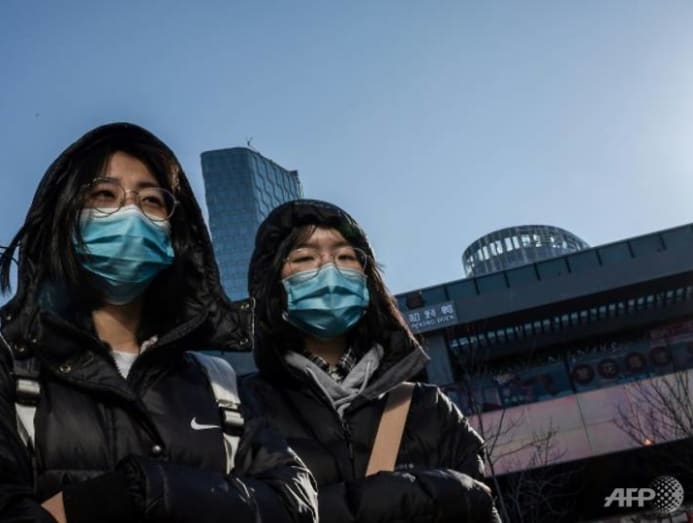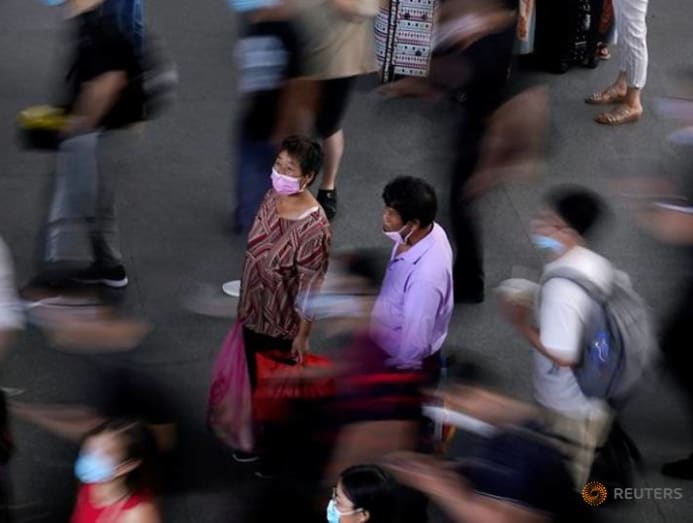Commentary: China’s COVID-19 successes - credible at home, not so much abroad
SINGAPORE: While the world is still dealing with the pandemic amongst new variants, China seemed to have kept COVID-19 largely under command.
Every bit of Jul 1, there accept been 91,780 infections in China, with 86,689 recovered and 4,636 deaths. The U.s. with a population i-quarter that of China, has virtually 33.6 1000000 cases and about 604,000 deaths.
What about Republic of india? Information technology has seen thirty.4 million infections and 398,000 deaths.
READ: Commentary: Survivors of Republic of india's ferocious second COVID-xix wave left scarred by crunch
A SWIFT RESPONSE TO CURTAIL SPREAD
Mainland china'south response was swift. The first cluster of pneumonia-like cases was reported in Wuhan, Hubei on December 31, 2019. Simply ten days later, China released the genomic sequence of the virus.
After that month, China began enacting a raft of countermeasures, placing Wuhan nether a strict lockdown, a hotly debated world first.
Similar measures were implemented in every urban center in Hubei, with 14,000 wellness checkpoints established at public transport hubs across the country.
People who crossed into marked exclusion zones were put on dwelling house quarantines and had to report their temperature for two weeks. School reopening were delayed. Population movements were curtailed.
Within weeks, Cathay tested 9 million people for the virus in Wuhan, and a national organisation of contacting tracing was prepare up.
Some of Red china's success in meeting the challenges of COVID-xix has been a function of luck. As the world'south largest manufacturer of personal protective equipment, China could ramp up the production of surgical masks.
Just much of the preparedness was rooted in a bad past feel.

The SARS outbreak in 2003 had a psychological touch on raising the alertness levels of order and regime. Information technology was a socio-political crisis for the country despite only over five,000 infections and 343 deaths recorded. Retail sales plummeted by half, 2 pct points in growth was shaved.
Little surprise and then that compliance amid the Chinese public to put on masks accept been loftier, even before beingness told to exercise so by authorities.
Vowing never again to remain vulnerable to such pandemic shocks, China had put in place drawer plans for a centralised epidemic response arrangement, allowing the central authorities to react apace to terminate the transmission, avert bureaucratic delays and tackle clusters.
The Epidemic Prevention and Control Headquarters System oversaw the deployment of community resources at the local level.
A Joint Prevention and Command Machinery established by the State Council in Jan, comprising 32 government agencies answerable to President Xi Jinping, directed and mobilised national resource – including the deployment of healthcare teams, the building of makeshift hospitals and the standardisation of healthcare measures.
In essence, People's republic of china's decisive response arises from a combination of a population that takes respiratory infections seriously and a government with the capability to put bigger constraints on individual freedoms less easily accepted in other countries.
READ: Commentary: How Tencent became world'south nearly valuable social media company – and then everything changed
READ: Commentary: Life in Prc after COVID-19 lockdown gives normal new pregnant
SCEPTICISM OVER CHINA'S COVID-nineteen Direction
Despite such recorded successes, there has been some scepticism over China's handling of COVID-nineteen and its official statistics suggesting the state has brought the virus to heel.
This scepticism stems from China's sketchy reputation in providing credible official numbers, its cover-up of the virus in Wuhan in early Jan 2020, and the changing goalposts on instance numbers where there were seven different definitions for COVID-19 issued past the National Health Committee at the onset of the outbreak.
All the same, at that place's simply scant evidence to advise any coordinated concealment of a large number of cases and deaths.
It is near impossible for word not to get out because the scale of people movements and the widespread use of social media similar Weibo and Douyin where citizens document, discuss and share developments.
READ: Commentary: Why the W has bug defining a articulate Red china policy

In just the offset week of Oct 2020, almost 637 million Chinese were travelling during the Golden Week holidays, not far behind the pre-pandemic equivalent of 782 million in 2019.
Chinese authorities would unlikely risk relaxing such rules if new cases remained high.
COVID-19 VACCINES: JURY IS STILL OUT
China has given more than than 1.18 billion vaccine shots. That means out of the iii.05 billion shots administered effectually the world, more than than a third has been in People's republic of china.
The sight of thousands watching the CCP's centenary celebrations this calendar week spoke volumes of how far the country has come up in beating back the pandemic. Other countries hope to go there before long.
Vaccines from Sinovac and Sinopharm, some of the get-go few approved for utilize terminal year, take made their way away.
As inactivated vaccines fabricated from viral particles produced in a lab, the technology is longstanding, similar to vaccines for polio, Hepatitis A and the flu.
READ: Commentary: Inaccurate public understanding of COVID-xix vaccine efficacy has implications for vaccination rates
Yet in clinical trials, Sinovac's efficacy at preventing symptomatic infection is lower than the mRNA vaccines at 51 per cent in Brazil, 67 per cent in Chile, 65 per cent in Indonesia, and 84 per cent in Turkey.
Despite assurances from the World Wellness Organisation (WHO) that Sinopharm and Sinovac vaccines are safe and efficacious, with both approved for emergency use by the WHO, there are serious questions over how effective the Chinese vaccines are in providing herd immunity and at least reduce the risk of spread and severe disease, particularly against new variants.
READ: Commentary: How COVID-19 vaccines are being weaponised equally countries jostle for influence
READ: Commentary: Variants versus vaccines is becoming the new COVID-19 race
Countries like Seychelles, which have mostly used the Chinese vaccines in their inoculation drives, accept seen cases rise. Bahrain and the United Arab Emirates take been offering booster shots to people who take had two shots of Sinopharm.
Similarly, Republic of indonesia has announced tighter restrictions just this week, on the back of news of ascent infection numbers including hundreds of medical workers vaccinated with Sinovac hospitalised with COVID-xix.
Republic of chile too has achieved loftier vaccine coverage, mostly with Sinovac. Around 75 per cent of the developed population has received one dose, and 58 per cent ii doses all the same the state had to impose a blanket lockdown in Santiago given a surge of infections in June that experts are saying may exist related to the more transmissible Gamma variant that first emerged in Brazil.
While communicable diseases experts interviewed past Bloomberg say the Chinese vaccines are nonetheless worth taking, they highlight the problem is the clinical information, which "did not include many old people or many people with co-morbidities".
(Are COVID-xix vaccines still constructive against new variants? And could these increase the gamble of reinfection? Experts explain why COVID-nineteen could go a "chronic problem" on CNA'south Heart of the Matter podcast.)
LAB LEAK THEORY: More than POLTICS THAN TRUTH
At that place's a new front on the horizon regarding People's republic of china'south success in dealing with COVID-xix: Whether the virus could have been deliberately developed in a lab.
Despite the lab-leak theory beingness given a fresh tour of life with US President Joe Biden ordering a further United states intelligence investigation, in that location has been no new testify the virus was developed in a laboratory setting in People's republic of china.
And yet while a WHO team of appointed scientists who were in Wuhan to investigate indicated that the lab-leak theory was "extremely unlikely" in March, they could not depict a firm conclusion.
Rumours have also swirled subsequently it was discovered last month that Peter Daszak, a fundamental organiser of the March 2022 statement in the Lancet dismissing the thought of a lab leak, had links to the Wuhan Establish of Virology.
READ: Commentary: What's really behind fresh calls for investigations into COVID-19 origins
READ: Commentary: Why the Wuhan lab-leak theory is back despite lack of new testify
Recent reports claiming several lab workers at the same constitute getting sick in November 2022 should be taken with a compression of caution.
More a secret plot to cover up a lab leak, the likely story hither is the complexity, self-involvement and political messiness in a blame game on the origins of the pandemic, mired in the international politics of the The states-China rivalry.
In essence, it would seem China does deserve some credit in fighting off COVID-19 to resume some semblance of domestic normalcy.
Nonetheless, outside its borders, the jury is still out regarding the state's credibility in fighting COVID-19 through the deployment of Mainland china-made vaccines when more than effective ones are available.
Ryan Ho is researcher at the NUS East Asian Institute.
0 Response to "Commentary: China’s COVID-19 successes - credible at home, not so much abroad"
Postar um comentário